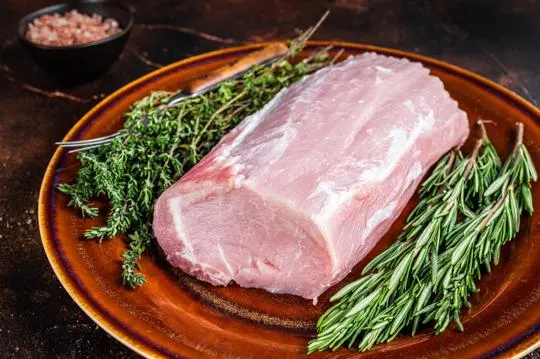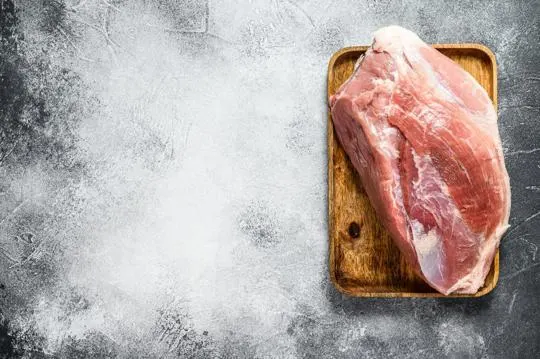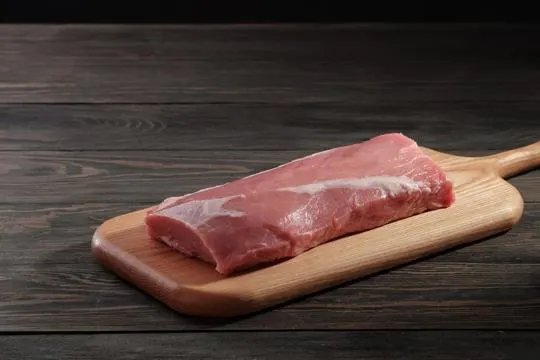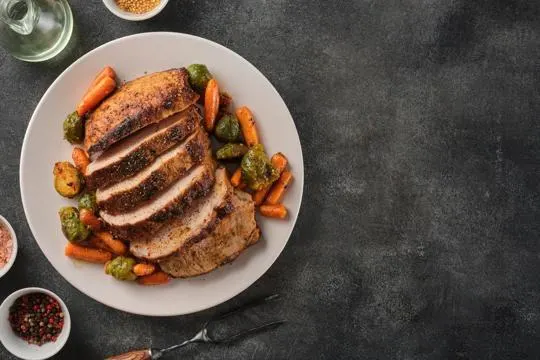Pork Loin and Butt might sound like the start of a bad joke we overheard at the barbecue pit.
We’ve all been there, standing in the supermarket aisle, pondering over packages, labels looking back at us. It’s the eternal question for the weekend grill feast. The confusion is real, friends.
Pork Loin is lean and fancy; she’s the elegant dinner party dish. Pork Butt, despite its name, sits up higher on the pig and is all about that fat and flavor.
We remember our first cookout mistake like it was yesterday – a mix-up between the two. A dry, slightly embarrassed loin served with a side of “Oops.”
Short. Sweet. To the point. That’s what this guide is.
What is Pork Loin?

Pork loin is a cut from the pig’s back.
Its tenderness and mild flavor make it a beloved choice for meals.
Plus, it has little fat and can be cooked easily.
To cook pork loin, there are a few techniques.
Roasting helps retain moisture and bring out the natural flavor.
Grilling adds a smoky, charred taste.
You can also cut it into chops or medallions for pan-frying or sautéing.
Pork loin absorbs flavors from marinades and spices.
So, it’s great for experimenting.
From classic herbs to exotics like ginger and soy sauce, there are endless flavor combos that work with pork loin.
What is Pork Butt?

Pork butt, also named Boston butt or pork shoulder, is a juicy cut of meat from a pig’s upper shoulder.
It’s well-marbled and full of flavor, often used for slow cooking like smoking, braising, or roasting.
It gets its name from the barrels, or “butts,” it used to be packed in during colonial times.
This cut of meat isn’t actually from the rear end of the pig though.
It comes from the front shoulder – including the blade bone and some fat.
The thing that makes pork butt special is its versatility in cooking.
It’s fatty and has a lot of connective tissues, so it can last long cooking times without drying out.
This makes it great for pulled pork or tender roasts that fall apart easily.
Differences Between Pork Loin and Pork Butt

Pork loin and pork butt are not the same.
Both come from different parts of the pig.
Location and Cut
When it comes to pork, it’s important to understand the differences.
Pork loin is from the back of the pig and is usually boneless, with less fat.
It’s perfect for roasting or grilling, as it cooks quickly and remains juicy and flavorful.
Pork butt isn’t from the rear of the pig, but from the shoulder area.
It has more fat marbling, making it ideal for braising, smoking, or pulled pork.
This allows the connective tissues to break down and create a melt-in-your-mouth texture.
Pork loin is leaner, with subtle flavors, while pork butt is fattier and more succulent.
Knowing the right location and cut can make a world of difference.
So next time you’re at the butcher shop or browsing recipes, keep in mind these distinctions.
Enjoy a gastronomic adventure like no other.
Texture and Flavor
When it comes to pork loin and pork butt, there are differences in texture and flavor.
Pork loin has a tender and juicy texture, with a hint of sweetness.
Its flavor is delicate and savory, making it a great choice for many cooking methods.
Pork butt has a more fatty and marbled texture.
Its taste is rich and succulent, giving it a melt-in-your-mouth experience.
The flavor is more pronounced and robust, so it works well with bold seasonings and marinades.
Pork loin comes from the back, while pork butt is from the shoulder.
They have different textures and flavors, making them perfect for different dishes.
Pork loin is good for quick cooking or grilling, and pork butt is ideal for slow-cooked recipes like pulled pork or braises.
In conclusion, understanding the differences between pork loin and butt can help you cook better.
Both cuts offer unique qualities which can make your dishes even better.
So don’t forget to experiment with them in your kitchen.
Best Cooking Methods
Cooking a pork loin or butt? Want delicious results? Know the best methods.
Different cuts need different approaches to bring out their flavor and texture.
Let’s explore some tried and true techniques.
- Roasting pork loin is popular. Preheat the oven, season the meat with herbs and spices, and place it in a roasting pan. Cook until the internal temperature reaches a safe level. Juicy and tender roast.
- Grilling is great for pork loin or butt. High heat creates a sear on the outside while keeping the inside moist and flavorful. Marinate beforehand for extra flavor. Watch it to prevent overcooking.
- Slow cooking is an excellent choice for pork butt. Cook at low temperatures over an extended period. The result? Melt-in-your-mouth tenderness.
Remember that pork loin is leaner than pork butt.
Different techniques work best for each cut, depending on composition and desired outcome.
Uses in Recipes
Pork loin and butt are two tasty cuts of meat with multiple uses.
Pork loin has a mild flavor, making it great for stir-fries, roasts, and kebabs.
Pork butt, or pork shoulder, is richer and more intense.
It’s perfect for slow-cooked dishes like pulled pork sandwiches, stews, and braises.
Pork loin is best cooked quickly over high heat, while pork butt needs low and slow methods like braising or smoking.
Both cuts are interchangeable in recipes, so you can pick whichever you prefer.
Knowing their unique qualities can help you choose the right cut for your next delicious meal.
Similarities Between Pork Loin and Pork Butt

Pork loin and pork butt come from the same animal – the pig.
Both have marbled fat, making them juicy and flavorful.
They can also be cooked in different ways.
However, pork loin is leaner, better for dishes like stir-fries or kebabs.
Pork butt has more fat and is best for slow-cooked meals.
It keeps the meat moist while cooking and adds flavor.
Nutritional Comparison
When it comes to pork loin and pork butt, the difference goes beyond their names.
Each cut has its own unique nutritional profile.
Pork loin, also known as tenderloin, is a lean cut.
It is low in fat and calories, making it a healthy option for those watching their weight.
A 3-ounce serving contains 120 calories and 2 grams of fat.
Plus, it has 22g of protein and many vitamins and minerals.
Pork butt, also called Boston butt or pork shoulder, has higher fat content.
This makes it juicier and tastier when cooked.
A 3-ounce serving has 290 calories and 20g of fat.
It still has 22g of protein and essential nutrients like iron, zinc, vitamin B12, riboflavin, and potassium.
Pork loin is lower in fat and calories, but the higher fat content in pork butt adds flavor.
The choice between these cuts depends on personal preference and diet goals.
How to Select and Store Pork Loin and Pork Butt?
It’s important to pick out and store pork loin and pork butt with care.
Here’s a guide to help you:
- Check the Color: Look for a pinkish-red hue. Avoid gray meat or dark spots.
- Inspect the Marbling: Thin streaks of fat show tenderness and flavor. Look for even distribution.
- Thickness Matters: Pick pork loin cuts of at least an inch thick. Pork butt can be thicker.
- Examine Fat Content: Minimal surface fat is best for loin, while some fat throughout is great for butt.
- Talk to the Butcher: Ask your butcher for advice on the best cuts for your recipe.
- Storage Tips: Refrigerate at temperatures below 40°F (4°C). Use in two days or wrap tightly in plastic or foil.
Also, store away from other raw meats.
This will keep them fresh and full of flavor.
Now you know how to choose and store pork loin and butt.
Enjoy cooking tasty meals.
Conclusion
Pork loin and butt are two cuts that come from different areas of the pig.
The loin is found in the back, and the butt is from the shoulder.
Cooking-wise, they offer different flavors and textures.
Pork loin is leaner and has a milder taste. It’s great for roasting or grilling.
Meanwhile, butt is fattier and has a stronger flavor. Perfect for slow cooking or braising.
When selecting between these two cuts, consider your cooking style and taste.
If you want something tender and low in fat, go for loin.
If you like moist and flavorful meat that falls apart, pick butt.
Marinating the meat before cooking can also add extra flavors.
You can use herbs, spices, citrus juices, or even beer.

Leave a comment